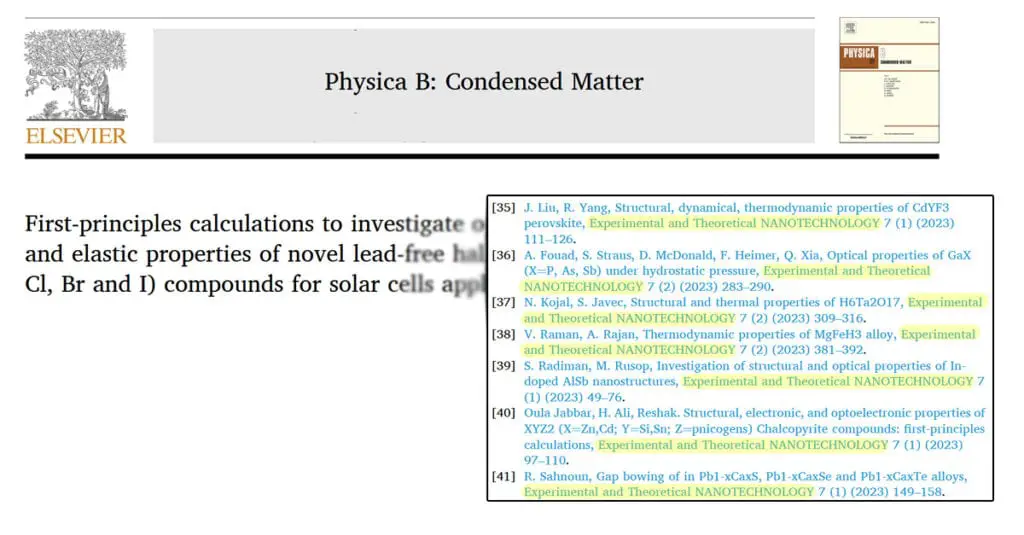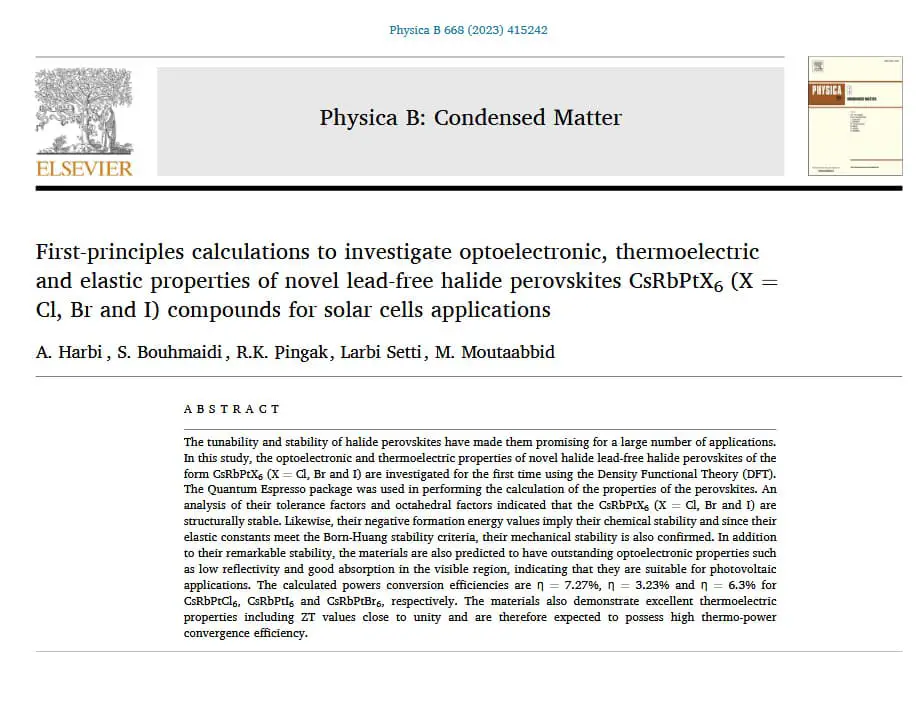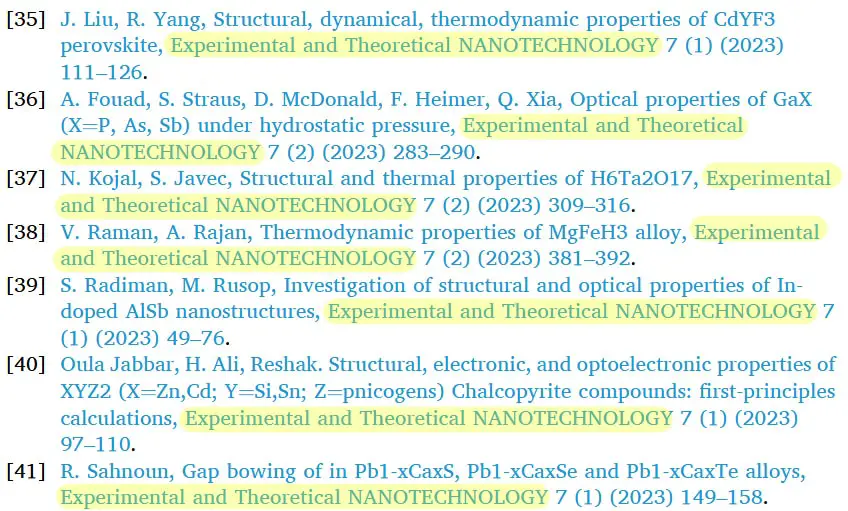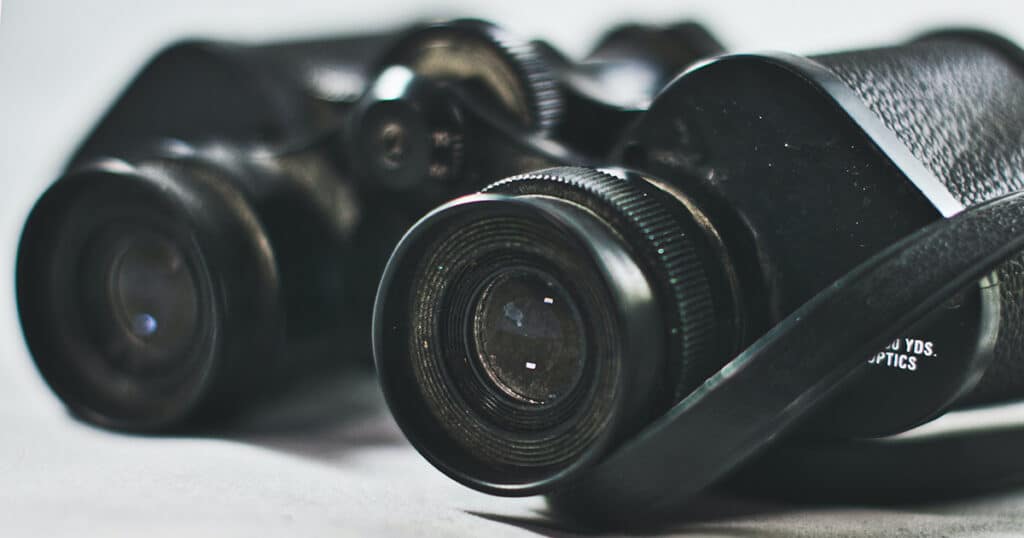Introduction
A tweet from Nick Wise grabbed our attention, so we decided to take a look.
The tweet said:
“In one generic sentence, this recent @ElsevierConnect paper adds 34 references. 35-41 are to the journal ET Nano, 24-34 and 42-57 all have Yarub Al-Douri as an author, the EiC of ET Nano. Would love to know who the reviewers were.“
Nick has made a comment on this article on PubPeer, in November 2023. At the time of writing no comments have been made to this PubPeer comment
The article
The article we are discussing is:
- A. Harbi, S. Bouhmaidi, R.K. Pingak, L. Setti, M. Moutaabbid (2023) First-principles calculations to investigate optoelectronic, thermoelectric and elastic properties of novel lead-free halide perovskites CsRbPtX6 (X = Cl, Br and I) compounds for solar cells applications. Physica B: Condensed Matter vol 668, 415242. DOI: 10.1016/j.physb.2023.415242.
Figure 1 shows an image of this paper.
Citations to Experimental and Theoretical NANOTECHNOLOGY
The journal
One of the observations made by Nick Wise was that the bibliography included seven citations to ET Nano (full name Experimental and Theoretical NANOTECHNOLOGY). See Figure 2.
This is a strange journal.
- It’s URL is https://www.siats.co.uk/pdf/ETN-Journal_members.pdf. Well, actually its a link to a pdf about the journal. We have archived this page here (21 Jan 2024).
We note that this is a United Kingdom domain. - Looking up its ISSN (2590-4132) on the ISSN portal, it has been registered in the United Arab Emirates.
- Searching for the journal, it has a web presence in Malaysia (which is where the EiC is based).
- We also looked on Google Scholar and found that the journal has an entry (archived here (21 Jan 2024)). This page has “Malaysian Institute of Science and Development” below the journal name, reinforcing the link to Malaysia. Yet, if you follow the homepage link you arrive at another journal, but if you follow the Wayback Machine home page link (going to an archived page from March 2023), you arrive at the right journal. This means that it has changed in the past year.
When looking at the various resources given above, it is quite difficult to find many details about the journal and those we did find are confusing, at best. For example, we struggled to find a table of contents so could not validate the citations given in the paper we are looking at.
We need to spend a lot more time looking at this journal, but hour or so we spent looking for it suggests that it will not be easy to piece together a coherent story.
We plan to return to this journal sometime in the future.
Link to ET NANO paperss
The papers in figure 2 do not have DOIs, which is the most preferred way (in our view) to access a paper, as it is a permalink.
However, as mentioned below, the papers are actually links so you should be taken directly to the paper.
All of the links have the form : http://refhub.elsevier.com/S0921-4526(23)00609-9/srefnn, where nn is the citation number.
The problem we found is that the links do not really work. They often take you to a Google Scholar page, or a different paper that the one cited. For example, [35], which has the link http://refhub.elsevier.com/S0921-4526(23)00609-9/sref35, is not the same paper that is cited.
These (seemingly) incorrect links is not the focus of this article, but it is something that we plan to return to.
The EiC of ET NANO has many papers cited
As noted by Nick Wise, citations [24-35; 42-57] are all authored by the Editor-in-Chief of ET NANO. Actually, we don’t think he is an author on [28]. Nevertheless, having 28 papers cited does seem rather excessive.
This is especially true when you consider that all the papers mentioned here (the ones published in ET NANO and those authored by the EiC of ET NANO) are all cited in a single sentence, that is:
“A number of studies have also been carried out to investigate a wide range of perovskites [24–35] as well as various physical systems [36–57].“
Even if these papers are “on topic” (and we are not discipline experts, so not qualified to judge), it does seem to be a high number of papers to support the points being made?
Like many aspects of this paper, further investigation is needed, but all these papers being cited in one sentence is worry (anyway), especially given the relationships that have been pointed out.
Other observations
We noted that [28] was not authored by the EiC of ET NANO, but it is authored by many of the same authors as the paper we are looking at. That is:
- S. Bouhmaidi, A. Harbi, R. K. Pingak, A. Azouaoui, M. Moutaabbid, L. Setti (2023) First-principles calculations to investigate lead-free double perovskites CsInSbAgX6 (X = Cl, Br and I) for optoelectronic and thermoelectric applications, Computational and Theoretical Chemistry, vol 1227, 114251. DOI: 10.1016/j.comptc.2023.114251.
We also note the similarity between the titles of the two papers.
Furthermore, the EiC of ET NANO is heavily cited in the above paper, in a similar way (i.e. en-bloc) to the paper that is the focus of this article. Again, this deserves a deeper investigation.
Our tweet
This article was motivated by the tweet from Nick Wise, to which we responded. These are the comments that we made in our tweet.
We took a look at the paper and these are comments we had:
- It’s interesting that all of those papers ([24-57) are fully “highlighted in blue” (on the PDF) – meaning that they are a hyperlink. This is normal, so that a reader can be taken directly to the paper that is being cited.
But the other papers that are being cited (apart from a couple) only have the DOI highlighted.
This suggests (to us anyway) that the 33 papers that are being discussed were edited in a different way to the others (added later?).
- As you say, it would be interesting to see the reviews. It would also be very interesting to see the paper that was submitted and the paper that was published and when these references appeared? Were they there in the original submission, or were they added later? And, if later, at what time during the peer review process?
- The journal in question (Physica B: Condensed Matter) has a (2022) @Scopus #CiteScore of 5.00 and has been indexed since 1998 (and also in 1994). Would Scopus investigate this potential citation stacking?
- The journal has a (2022) @Clarivate impact factor of 2.8. It has been indexed by #WebOfKnowldge since 1997. Same question as to Scopus – will you investigate this potential citation stacking?
- The journal (ISSN: 0921-4526) is a member of @C0PE (Committee on Publication Ethics). Do they have the “teeth” to investigate a paper from one of its members, or at least ask to to see the timeline, review reports etc?
- Can any of the editors help explain what happened with this paper and is everything as it should be?
- Finally, we assume that Elsevier will be interested in this paper and will investigate – again, knowing that it all might be okay?
Final Comments
When we first saw Nick Wise’s tweet, we were quite surprised, but we have got even more surprised as we have dug deeper.
Overall though, we are left with a frustrated feeling as we feel that we have opened up more questions than we have answered. We hope to return to these unanswered questions as soon as we can, but we know that they will take time to answer.
In the meantime, we can only hope that Elsevier take a look at this paper. Perhaps they will find nothing wrong but at least respond to the PubPeer comment, even if to say that they have investigated and found that all due processes were followed.




